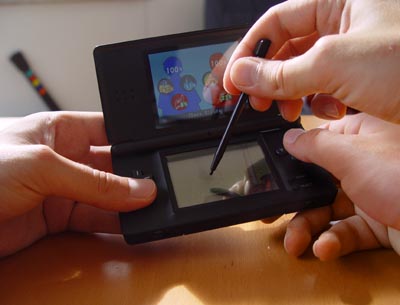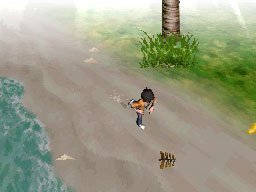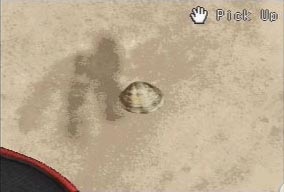This time, I will write something short about one of my favourite topics. I have already discussed that good gameplay sometimes results from bad usability. This time, I would like to show how bad usability can spoil a game, like it is a case in Lost in Blue for the Nintendo DS.

Position your hands like that for the most comfortable “Lost in Blue” expierience. You can use your 5 other hands to scratch your head or have a drink.
People say that if you want to learn how to make good movies, it is helpful to watch the not-so-good movies. Good movies are “closed”, they don’t allow any insight into how they work. It is the same with games, which is why I like Lost in Blue so much. It has some realy good ideas but also some bad flaws. I suggest taking a look at it because it is rare and might disappear with time. You can learn a lot about game design from it.
In Lost in Blue, you are a boy stranded on an island with a girl. You task is to survive and get off the island. You control the boy from a top-down perspective, just like in Zelda. You have to find and collect food and various resources in order to survive. The games uses the touch screen of the DS in a few cases. You can use the stylus to shake trees in search of fruit. Also, sometimes you can find objects burried in the sand and dig them out with the stylus. This is reminiscent of the “Seeker” minigame in Project Rub (aka Feel the Magic: XY/XX).

“Previously on LOST…”
But here is how it works. You walk around just like you would in Zelda, using the left hand to move with the d-pad and the right hand to press the other buttons, like A for climbing or B for running. If you want to shake a tree, you have to remove your right hand from the buttons, grab the stylus and touch a tree with it. The view changes to fake first-person-view and you can proceed to shake the tree by rubbing it with the stylus. Sometimes you will get a fruit, most of the time nothing happens. To exit the fake first-person-view, you have to put the stylus back and use you right hand to press the B button. The procedure for digging for stuff and catching crabs is similar.

Time to eat!
This sounds quite reasonable at first, but if you think ahead, you will understand the problem. When searching for food, you want to check every tree and every heap of sand. It means that you want to repeat the procedure often and quickly. The game forces you, however to constantly change between the buttons and the stylus which is quite tendious. If you want to catch a crab or a turtle you have to repeat that procedure no less then 10 times until you find one.
Considering that tree fruit, clams and crabs are so rare and no more nutritous then fish, which is much less tendious to catch, the player will quickly learn to ignore that possibility and eat fish only. Most of the players will never know that there are turtles in the game because they can be found in latter areas. By the time the players reach those ares, they have given up searching the ground completly.
It hurts to see a game suffer so much from the lack of a tiny, single button. An on-screen button to exit the first-person-view using the stylus would make the whole process so much easier. Of course, you could go even further and drop the first-person-view completly but that would mean sacrificing on otherwise excellent gameplay element for the sake of usability, like already mentioned in the Street Rod article.
The interesting thing about Lost in Blue is that it is full of new and exciting ideas but it is riddled with more of those tiny usability flaws. It is possible to use the stylus to navigate some of the in-game menus but for some reason the execution of this feature is quite poor. Just like when you use the buttons, you select an item before you can use it. So you have to double-tap everything when you use the stylus. In some menus, the stylus can’t be used for some reason so in the end, you will use just the buttons anyway.
Also, you go to sleep by pressing the A button while standing on your bed. The A button is also used to search the ground, talk to the girl, make fire, build furniture, etc. It happens quite often that you accidently go to sleep. This is a bad thing if you accidently go to sleep at 12:00, loosing a whole afternoon. It is even especially annoing if you were about to eat and now instead starve while asleep. Ironically, the game always asks you if you want to save before going to sleep, but you can only answer “yes” or “no”. There is no “cancel”.
Although sometimes, a game designer might want to consider poor usability if it enrichens the gameplay, there is no excuse for poor usability without any reason. It is extremly important for the game designer to observe and understand if a part of an interface contributes to the game experience or not. In games, players expose themselves to the interface voluntarily so in the best case, they will avoid bad designed elements of the interface rendering a part of your content redundant. In the worst case, they simply become frustrated and maybe even quit playing.






the Street Rod link is broken, the correct link is:
http://gamedesignreviews.com/reviews/street-rod-game-design-and-usability/
Thanks for pointing this out, Chris. I’m sorry, some of the links are not up-to-date since I moved the blog. I’m glad you’re helping me out here.